1992 VOLKSWAGEN CARAVELLE towing
[x] Cancel search: towingPage 84 of 164
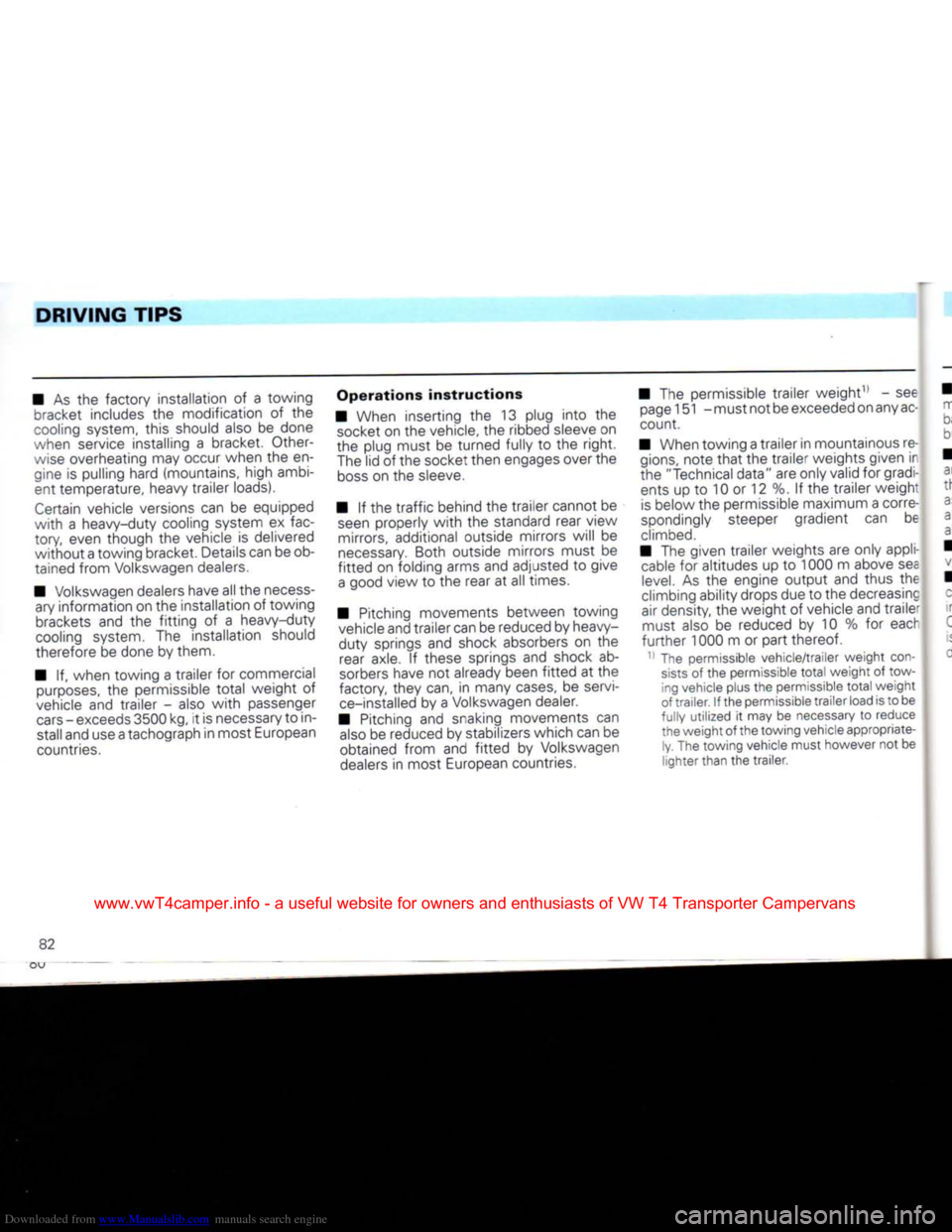
Downloaded from www.Manualslib.com manuals search engine
DRIVING
TIPS
• As the factory installation of a towing bracket includes the modification of the
cooling
system, this should also be done
when service installing a bracket. Other
wise
overheating may occur when the en gine is pulling hard (mountains, high ambi
ent temperature, heavy trailer loads).
Certain
vehicle versions can be equipped
with
a heavy-duty cooling system ex fac
tory,
even though the vehicle is delivered
without
a towing bracket. Details can be ob
tained from Volkswagen dealers.
• Volkswagen dealers have all the
necess
ary information on the installation of towing
brackets
and the
fitting
of a heavy-duty
cooling
system. The installation should
therefore be done by them.
• If, when towing a trailer for commercial
purposes,
the permissible
total
weight of
vehicle
and trailer - also
with
passenger
cars
- exceeds 3500 kg, it is necessary to in
stall and use a tachograph in most European
countries.
Operations
instructions
• When inserting the 13 plug
into
the
socket
on the vehicle, the ribbed sleeve on
the plug must be turned fully to the
right.
The
lid of the socket then engages over the
boss
on the
sleeve.
• If the
traffic
behind the trailer cannot be
seen
properly
with
the standard rear view mirrors, additional outside mirrors will be
necessary.
Both outside mirrors must be
fitted
on folding arms and adjusted to give
a
good view to the rear at all times.
• Pitching movements between towing
vehicle
and trailer can be reduced by heavy-
duty springs and shock absorbers on the rear axle. If these springs and shock ab
sorbers
have not already been
fitted
at the
factory, they can, in many
cases,
be servi
ce-installed
by a Volkswagen dealer.
• Pitching and snaking movements can
also
be reduced by stabilizers which can be
obtained from and
fitted
by Volkswagen
dealers
in most European countries. • The permissible trailer weight11 - see
page
151 -must not be
exceeded
on any
ac
count.
• When towing a trailer in mountainous re
gions,
note
that
the trailer weights given ir
the "Technical data" are only valid for gradi ents up to 10 or 12 %. If the trailer weigh'
is
below the permissible maximum a corre
spondingly steeper gradient can be
climbed.
• The given trailer weights are only appli
cable
for altitudes up to 1000 m above see
level.
As the engine
output
and thus the
climbing ability drops due to the decreasing
air density, the weight of vehicle and trailer must also be reduced by 10 % for eacr
further
1000 m or part thereof.
1 The permissible vehicle/trailer weight
con
sists
of the permissible
total
weight of towing vehicle plus the permissible
total
weight
of trailer. If the permissible trailer load is to be
fully utilized it may be necessary to reduce
the weight of the towing vehicle appropriate ly. The towing vehicle must however not be
lighter than the trailer.
82
www.vwT4camper.info - a useful website for owners and enthusiasts of VW T4 Transporter Campervans
Page 85 of 164

Downloaded from www.Manualslib.com manuals search engine
DRIVING
TIPS
• Where possible make
full
use of the maximum permissible drawbar weight on
call
of the towing bracket - see page 151 -
cut do not exceed it.
• While observing the permissible trailer
and
drawbar weight, distribute the load in
the trailer so
that
heavy objects are as near
as
possible to the axle. The objects must
a
so be secured so
that
they cannot slip
aoout.
• Check the
tyre
pressures on the towing
/ehicle
and the trailer.
• The headlight settings, should be
:hecked
with
trailer attached before mov- ng off and adjusted as necessary.
On
vehicles
with
headlight beam control it
is
only necessary to
turn
the knurled disc in
:ash
in the appropriate direction.
Driving
instructions
To
obtain the best possible handling of ve
hicle
and trailer, the following should be
noted:
• Try to avoid driving
with
an unladen ve
hicle
and a loaded trailer. If this cannot be
avoided,
only drive slowly to allow for the unfavourable weight distribution.
• As driving stability of vehicle and trailer
decreases
when the speed increases do not
drive at the maximum permissible top
speed
in unfavourable road, weather or
wind conditions - particularly when going downhill. In any
case
the speed must be reduced im
mediately the trailer shows the slightest
sign
of snaking. On no account try to stop
the snaking by accelerating.
• For safety reasons one should not drive faster than 80 km/h (50 mph). This also
applies
in countries where higher speeds
are permitted. • Always brake in good time. If the trailer
has
an overrun brake, apply the brakes gen
tly at
first
then firmly. This will avoid the
jerk
ing caused by the trailer wheels locking.
Change
down before going down a steep hill so
that
the engine can act as a brake.
• When a long climb in a low gear
with
ex tremely high engine revs must be nego
tiated at exceptionally high ambient temperatures the coolant temperature gauge must be observed. When the gauge needle
moves
to the
>~zza'
e~z of :ne
scale,
the road speed must be reduced immediately. If nevertheless ~g amp flashes,
stop immediately and si ow the engine to
cool
off at idling speed for several minutes.
• The cooling effect of the radiator fan
can
not be increased by changing down, be
cause
the speec of t~e
~a~
s ~o! dependent
on the engine
speed.
One should therefore not change down even when towing a
trailer as long as :-e e-g -e zar cope with out the vehicle speed dropping too much.
83
www.vwT4camper.info - a useful website for owners and enthusiasts of VW T4 Transporter Campervans
Page 86 of 164
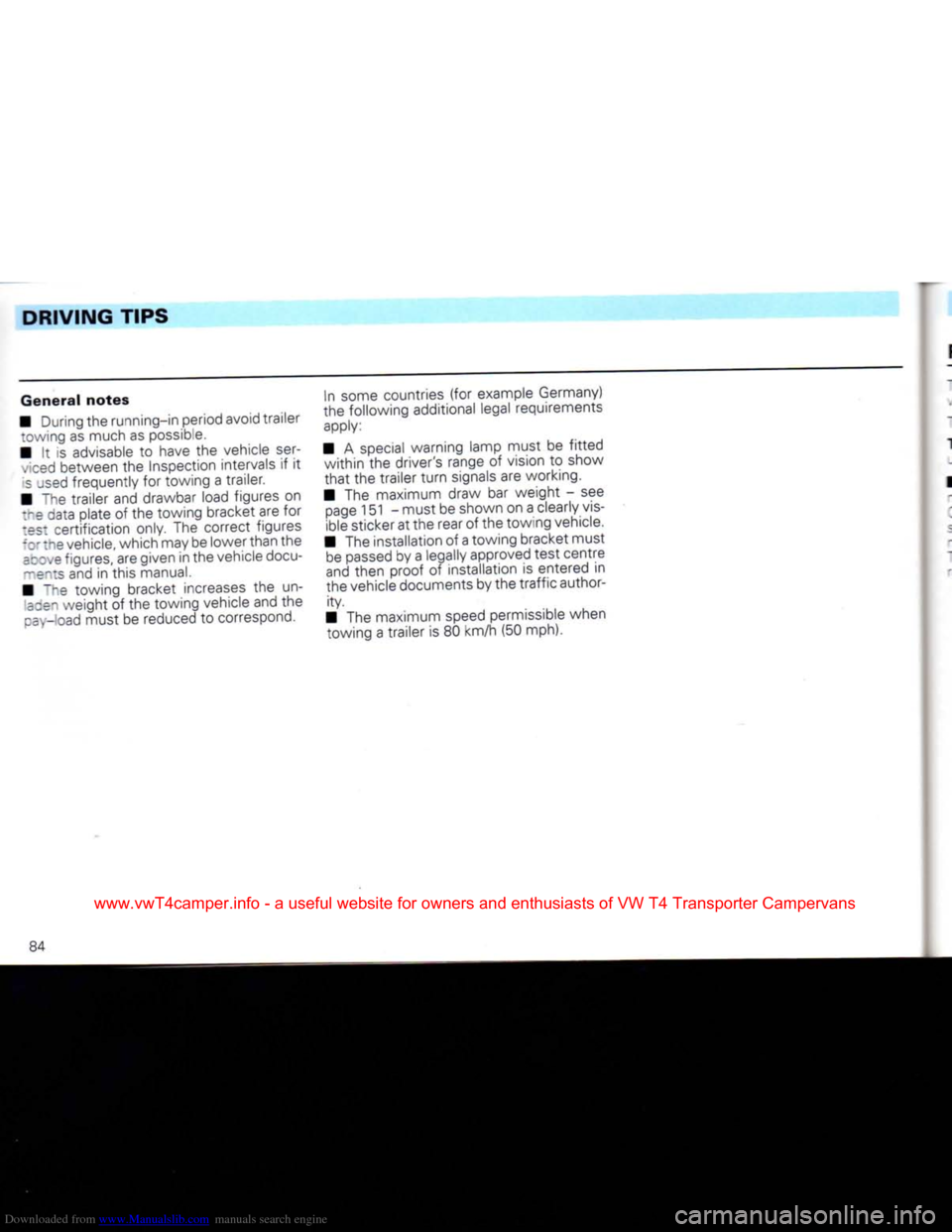
Downloaded from www.Manualslib.com manuals search engine
DRIVING
TIPS
General
notes
• During the running-in period avoid trailer "owing as much as possible.
• It is advisable to have the vehicle ser-
.ced
between the Inspection intervals if it
s
used frequently for towing a trailer.
• ""he trailer and drawbar load figures on
:re
data plate of the towing bracket are for
:es:
certification only. The correct figures
forthe
vehicle, which may be lower than the
acove
figures, are given in the vehicle docu-
~e~:s
and in this manual.
• The towing bracket increases the un-
535"
weight of the towing vehicle and the
pay-load
must be reduced to correspond. In some countries (for example Germany)
the following additional legal requirements
apply:
• A special warning lamp must be
fitted
within
the driver's range of vision to show
that
the trailer
turn
signals are working.
• The maximum draw bar weight - see
page
151 - must be shown on a clearly
vis
ible sticker at the rear of the towing vehicle.
• The installation of a towing bracket must
be
passed by a legally approved test centre
and
then proof of installation is entered in
the vehicle documents by the
traffic
author ity.
• The maximum speed permissible when towing a trailer is 80 km/h (50 mph).
84
www.vwT4camper.info - a useful website for owners and enthusiasts of VW T4 Transporter Campervans
Page 99 of 164
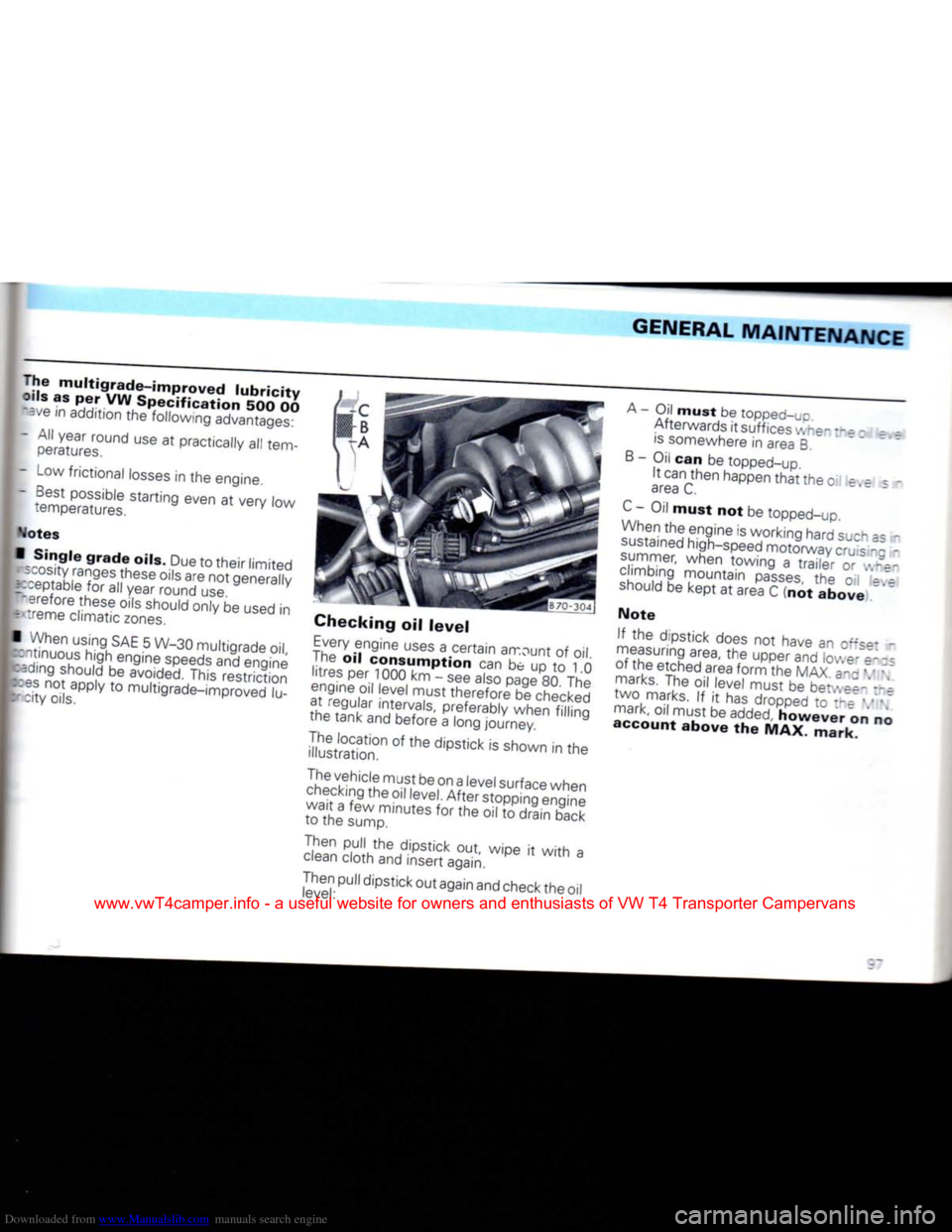
Downloaded from www.Manualslib.com manuals search engine
GENERAL
MAINTENANCE
The
multigrade-improved
lubricity
oils as per VW
Specification
500 00 m/e in addition the following advantages:
-
All year round use at practically all tem peratures.
-
Low frictional
losses
in the engine.
-
Best possible starting even at very low temperatures.
»Jotes
I
Single
grade
oils. Due to their limited
i-scosity
ranges these oils are not generally
j_::eptable for all year round use. "erefore these oils should only be used in
-
:reme climatic
zones.
•
When using SAE 5 W-30 multigrade oil, xntinuous high engine speeds and engine
seeding
should be avoided. This restriction
::es
not apply to multigrade-improved lu-
r city oils.
Checking
oil
level
Every
engine uses a certain amount of oil.
The
oil
consumption
can be up to 1.0
litres per 1000 km - see also page 80. The
engine oil level must therefore be checked
at regular intervals, preferably when filling
the tank and before a long journey.
The
location of the dipstick is shown in the illustration.
The
vehicle must be on a level surface when
checking
the oil level. After stopping engine
wait a few minutes for the oil to drain back
to the sump.
Then
pull the dipstick out, wipe it
with
a
clean
cloth and insert again.
Then
pull dipstick out again and check the oil
level:
A
- Oil
must
be topped-L.c.
Afterwards it suffices v.-5-:_e : e e
is
somewhere in area B.
B
- Oil can be topped-up. It can then happen
that
the c e.e s -
area
C.
C
- Oil
must
not be topped-up.
When
the engine is working hard sue as -
sustained
high-speed motorway cruising in
summer, when towing a trailer or :re~
climbing mountain
passes,
the c: e.e
should
be kept at area C (not
above
Note
If the dipstick does not have a- c"ee: -
measuring
area,
the upper and lows- e~zi
of the etched area form the MAX.
a~
z '.'
marks.
The oil level must be betv.ee- re
two marks. If it has dropped to 're '.' ". mark, oil must be added,
however
on no
account
above
the MAX.
mark.
www.vwT4camper.info - a useful website for owners and enthusiasts of VW T4 Transporter Campervans
Page 117 of 164
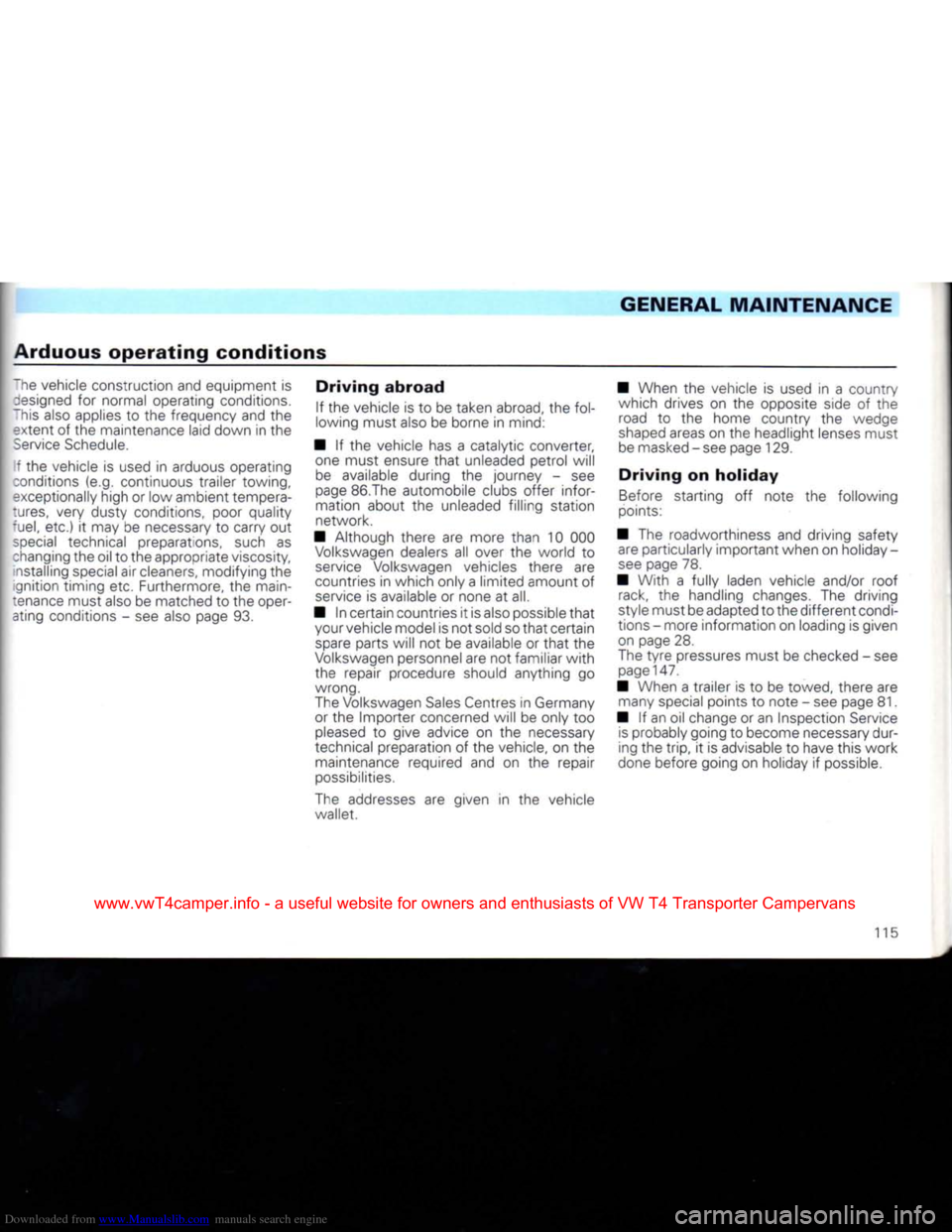
Downloaded from www.Manualslib.com manuals search engine
GENERAL
MAINTENANCE
Arduous
operating
conditions
ne vehicle construction and equipment is
resigned for normal operating conditions.
his also applies to the frequency and the
extent of the maintenance laid down in the
service
Schedule.
f the vehicle is used in arduous operating
conditions (e.g. continuous trailer towing,
exceptionally high or low ambient tempera-
:ures,
very dusty conditions, poor quality
ruel,
etc.) it may be necessary to carry out
special
technical preparations, such as ;hanging the oil to the appropriate viscosity, ^stalling special air cleaners, modifying the
ignition timing etc. Furthermore, the main
tenance must also be matched to the oper
ating conditions - see also page 93.
Driving
abroad
If the vehicle is to be taken abroad, the fol
lowing must also be borne in mind:
• If the vehicle has a catalytic converter, one must ensure
that
unleaded petrol will be available during the journey - see
page 86.The automobile clubs offer infor mation about the unleaded filling station
network.
• Although there are more than 10 000
Volkswagen
dealers all over the world to
service
Volkswagen vehicles there are
countries in which only a limited amount of
service
is available or none at all.
• In certain countries it is also possible
that
your vehicle model is not soid so
that
certain
spare
parts will not be available or
that
the
Volkswagen
personnel are not familiar
with
the repair procedure should anything go
wrong.
The Volkswagen
Sales
Centres in Germany or the
Importer
concerned will be only too
pleased
to give advice on the necessary
technical preparation of the vehicle, on the maintenance required and on the repair
possibilities.
The addresses are given in the vehicle wallet. • When the vehicle is used in a country
which drives on the opposite side of the road to the home country the wedge
shaped
areas on the headlight lenses must be masked - see page 129.
Driving
on
holiday
Before starting off note the following
points:
• The roadworthiness and driving safety are particularly important when on holiday-
see
page 78.
• With a fully laden vehicle and/or roof rack, the handling changes. The driving
style must be adapted to the different condi
tions - more information on loading is given
on page 28.
The
tyre
pressures must be checked - see
page147.
• When a trailer is to be towed, there are many special points to note - see page 81.
• If an oil change or an Inspection Service
is
probably going to become necessary dur
ing the
trip,
it is advisable to have this work
done before going on holiday if possible.
115
www.vwT4camper.info - a useful website for owners and enthusiasts of VW T4 Transporter Campervans
Page 134 of 164
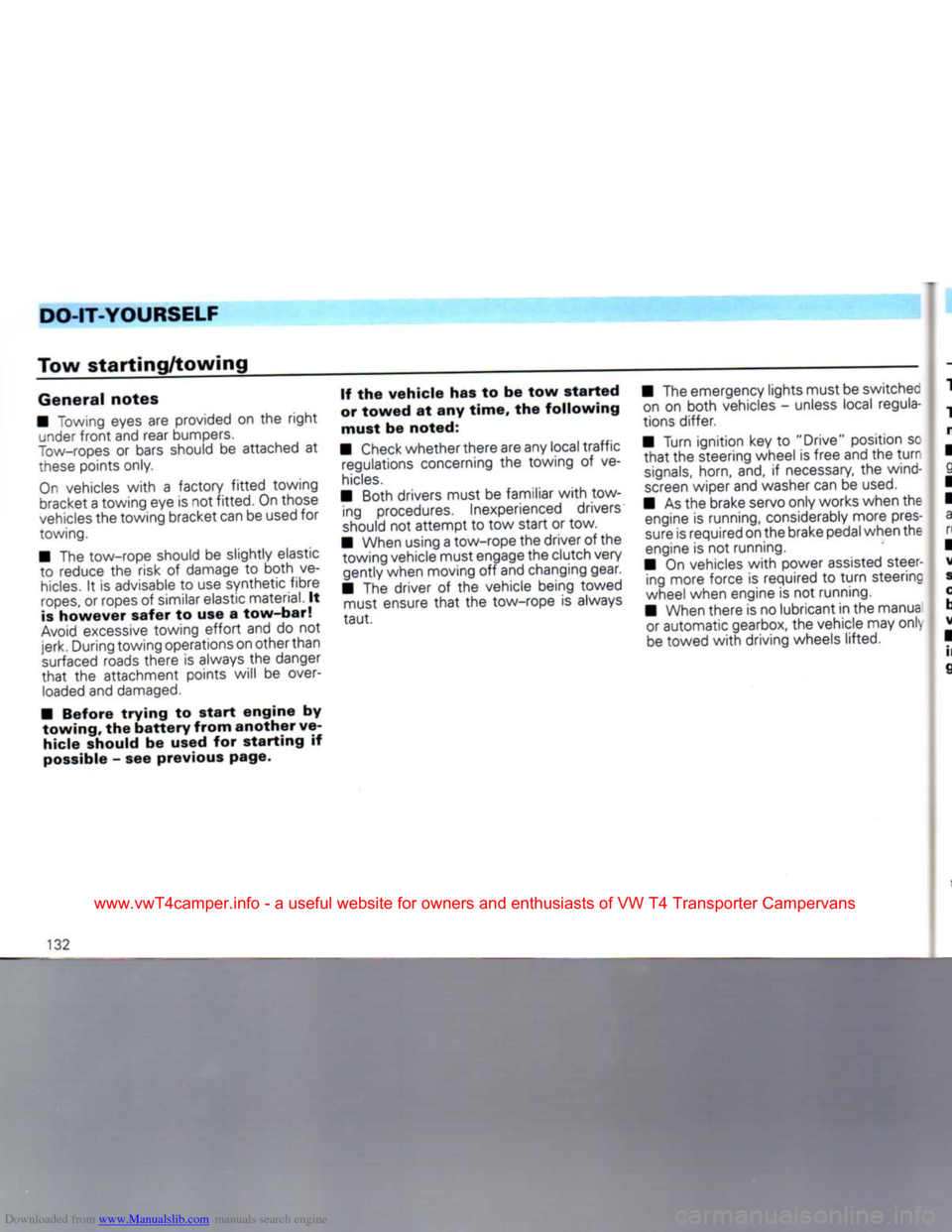
Downloaded from www.Manualslib.com manuals search engine
DO-IT-YOURSELF
Tow
starting/towing
General
notes
• "owing eyes are provided on the
right
under
front
and rear bumpers.
Tow-ropes
or bars should be attached at
these
points only.
On
vehicles
with
a factory
fitted
towing bracket a towing eye is not fitted. On those
vehicles
the towing bracket can be used for
towing.
• The tow-rope should be slightly elastic to reduce the risk of damage to both ve
hicles.
It is advisable to use synthetic fibre
ropes,
or ropes of similar elastic material. It
is
however
safer
to use a
tow-bar!
Avoid
excessive towing
effort
and do not
jerk.
During towing operations on other than
surfaced
roads there is always the danger
that
the attachment points will be over
loaded
and damaged.
•
Before
trying
to
start
engine
by
towing,
the
battery
from
another
ve
hicle
should be used for
starting
if
possible - see previous page. If the
vehicle
has to be tow
started
or
towed
at any
time,
the
following
must
be noted:
•
Check
whether there are any local traffic regulations concerning the towing of ve
hicles.
• Both drivers must be familiar
with
tow ing procedures. Inexperienced drivers
should
not attempt to tow start or tow.
• When using a tow-rope the driver of the towing vehicle must engage the clutch very gently when moving off and changing gear.
• The driver of the vehicle being towed must ensure
that
the tow-rope is always
taut.
• The emergency lights must be switchec
on on both vehicles - unless local regula
tions differ.
• Turn ignition key to "Drive" position sc
that
the steering wheel is free and the
turr
signals,
horn, and, if necessary, the wind
screen
wiper and washer can be
used.
• As the brake servo only works when the engine is running, considerably more pres
sure
is required on the brake pedal when the
engine is not running.
• On vehicles
with
power assisted steer ing more force is required to
turn
steering
wheel when engine is not running.
• When there is no lubricant in the manua or automatic gearbox, the vehicle may only
be
towed
with
driving wheels lifted.
132
www.vwT4camper.info - a useful website for owners and enthusiasts of VW T4 Transporter Campervans
Page 135 of 164
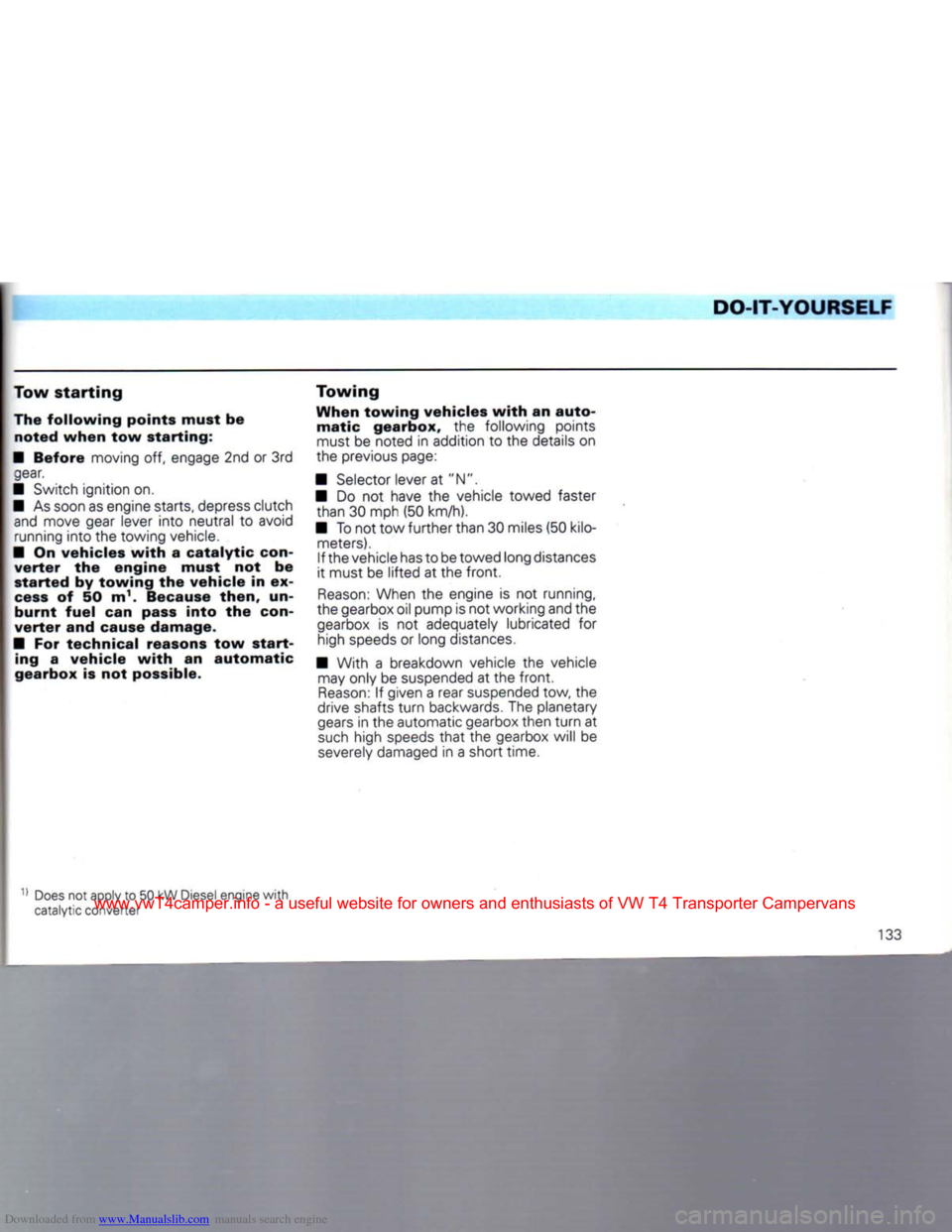
Downloaded from www.Manualslib.com manuals search engine
DO-IT-YOURSELF
Tow
starting
The
following
points
must
be
noted
when
tow
starting:
•
Before
moving off, engage 2nd or 3rd gear.
• Switch ignition on.
• As soon as engine starts, depress clutch and move gear lever
into
neutral to avoid running
into
the towing vehicle.
• On
vehicles
with
a
catalytic
con
verter
the
engine
must
not be
started
by
towing
the
vehicle
in ex
cess of 50 m1. Because
then,
un-
burnt
fuel
can pass
into
the con
verter
and cause
damage.
• For
technical
reasons tow
start
ing a
vehicle
with
an
automatic
gearbox
is not possible.
Towing
When
towing
vehicles
with
an
auto
matic
gearbox,
the following points must be noted in addition to the details on
the previous page:
• Selector lever at "N".
• Do not have the vehicle towed faster than 30 mph (50 km/h).
• To not tow
further
than 30 miles (50 kilo meters). If the vehicle has to be towed long distances
it must be
lifted
at the
front.
Reason:
When the engine is not running,
the gearbox oil pump is not working and the
gearbox is not adequately lubricated for high speeds or long distances.
• With a breakdown vehicle the vehicle may only be suspended at the
front.
Reason:
If given a rear suspended tow, the
drive shafts
turn
backwards. The planetary
gears
in the automatic gearbox then
turn
at
such
high speeds
that
the gearbox will be
severely
damaged in a short time.
Does
not apply to 50 kW Diesel engine
with
catalytic converter
133
www.vwT4camper.info - a useful website for owners and enthusiasts of VW T4 Transporter Campervans
Page 152 of 164
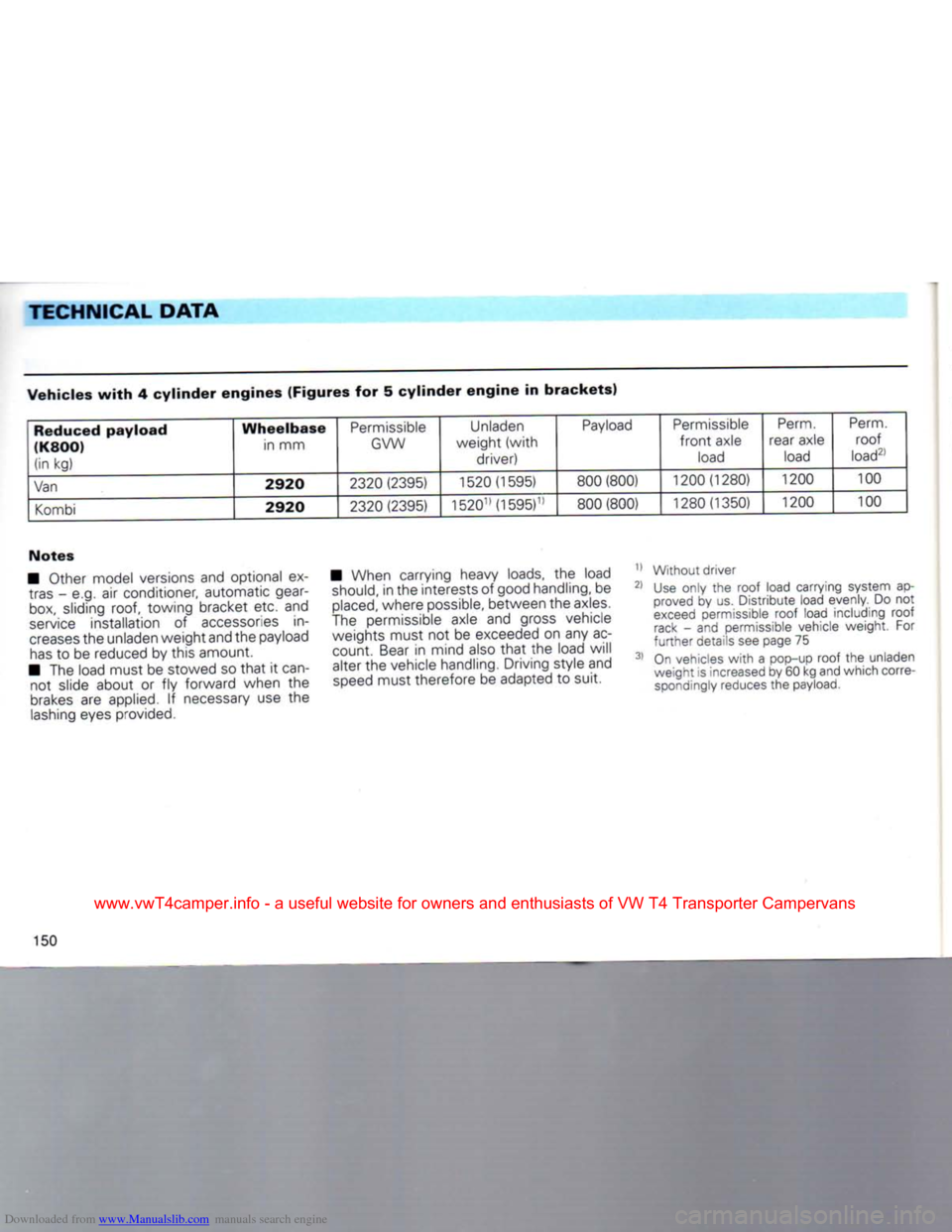
Downloaded from www.Manualslib.com manuals search engine
TECHNICAL DATA
Vehicles
with 4
cylinder
engines
(Figures
for 5
cylinder
engine
in
brackets)
Reduced
payload
(K800)
(in
kg)
Wheelbase
in
mm
Permissible
GVW
Unladen
weight
(with
driver)
Payload
Permissible
front
axle load
Perm,
rear axle load
Perm,
roof
load21
Van
2920
2320 (2395) 1520 (1595)
800 (800) 1200 (1280) 1200 100
Kombi
2920
2320 (2395)
152011
(1595)11 800 (800) 1280 (1350) 1200 100
Notes
• Other model versions
and
optional
ex
tras
-
e.g.
air
conditioner, automatic gearbox, sliding
roof,
towing bracket
etc. and
service
installation
of
accessories
in
creases
the unladen weight and the payload
has
to be
reduced
by
this amount.
•
The
load must
be
stowed
so
that
it
can
not slide about
or fly
forward when
the
brakes
are
applied.
If
necessary
use the
lashing eyes provided. • When carrying heavy loads,
the
load
should,
in
the
interests
of
good handling,
be
placed,
where possible, between
the
axles.
The permissible axle
and
gross vehicle weights must
not be
exceeded
on any
ac
count. Bear
in
mind also
that
the
load will
alter
the
vehicle handling. Driving style
and
speed
must therefore
be
adapted
to
suit. Without driver
Use
only
the
roof load carrying system
ap
proved
by us.
Distribute load evenly.
Do not
exceed
permissible roof load including roof rack
- and
permissible vehicle weight.
For
further
details see page
75
On
vehicles
with
a
pop-up roof
the
unladen
weight
is
increased
by 60 kg
and which corre
spondingly reduces
the
payload.
150
www.vwT4camper.info - a useful website for owners and enthusiasts of VW T4 Transporter Campervans